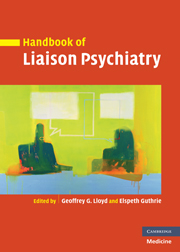Book contents
- Frontmatter
- Contents
- List of contributors
- Preface
- Part I Basic skills
- Part II Common psychiatric problems across the general hospital
- Part III Working with specific units
- 14 Neurological disorders
- 15 Cardiorespiratory disorders
- 16 Gastrointestinal disorders
- 17 Liver disorders
- 18 Endocrine disorders
- 19 Diabetes
- 20 HIV and AIDS
- 21 Renal disease
- 22 Musculo-skeletal disorders
- 23 Oncology
- 24 Head and neck cancer
- 25 Palliative care
- 26 Cosmetic procedures
- 27 Perinatal and gynaecological disorders
- 28 The intensive care unit
- 29 The burns unit
- 30 Psychocutaneous disorders
- 31 Genitourinary disorders
- 32 The emergency department
- Part IV Treatment
- Part V Different treatment settings
- Index
- References
18 - Endocrine disorders
from Part III - Working with specific units
Published online by Cambridge University Press: 10 December 2009
- Frontmatter
- Contents
- List of contributors
- Preface
- Part I Basic skills
- Part II Common psychiatric problems across the general hospital
- Part III Working with specific units
- 14 Neurological disorders
- 15 Cardiorespiratory disorders
- 16 Gastrointestinal disorders
- 17 Liver disorders
- 18 Endocrine disorders
- 19 Diabetes
- 20 HIV and AIDS
- 21 Renal disease
- 22 Musculo-skeletal disorders
- 23 Oncology
- 24 Head and neck cancer
- 25 Palliative care
- 26 Cosmetic procedures
- 27 Perinatal and gynaecological disorders
- 28 The intensive care unit
- 29 The burns unit
- 30 Psychocutaneous disorders
- 31 Genitourinary disorders
- 32 The emergency department
- Part IV Treatment
- Part V Different treatment settings
- Index
- References
Summary
Introduction
The relationships between endocrine disturbances and psychiatric conditions have stirred considerable interest for several reasons (Lishman 1998). Historically, several authors have speculated about the role of hormones and endocrine disorders in relation to psychiatric conditions, and attention has been devoted to the role of hormones in relation to control and feedback processes in neural structures (Carroll et al. 1981). Psychiatric syndromes have consistently been described or documented in endocrine diseases (Kathol 2002; Lishman 1998) and may pose a real clinical challenge for the liaison psychiatrist, but the evidence in the literature to support his or her intervention is limited. This chapter reviews available data in relation to the characteristics and frequency of specific psychiatric syndromes in primary endocrine disturbances; issues of diagnosis and differential diagnosis; mechanisms of production of psychiatric symptomatology; and treatment issues, including response of psychiatric syndromes to treatment of the endocrinopathy and to psychotropic medication.
Epidemiology
Some experts have suggested that the most severe psychiatric syndromes are not as prevalent as in the past, due to improvements in diagnosis and treatment of endocrine diseases (Kathol 2002). Still, a high prevalence of psychiatric disturbances has been reported in most endocrine conditions, depression and anxiety being the most common presentations (Tables 18.1 and 18.2). As expected, lifetime prevalence is even higher in several reports (Eiber et al. 1997).
Keywords
- Type
- Chapter
- Information
- Handbook of Liaison Psychiatry , pp. 432 - 453Publisher: Cambridge University PressPrint publication year: 2007
References
- 1
- Cited by

